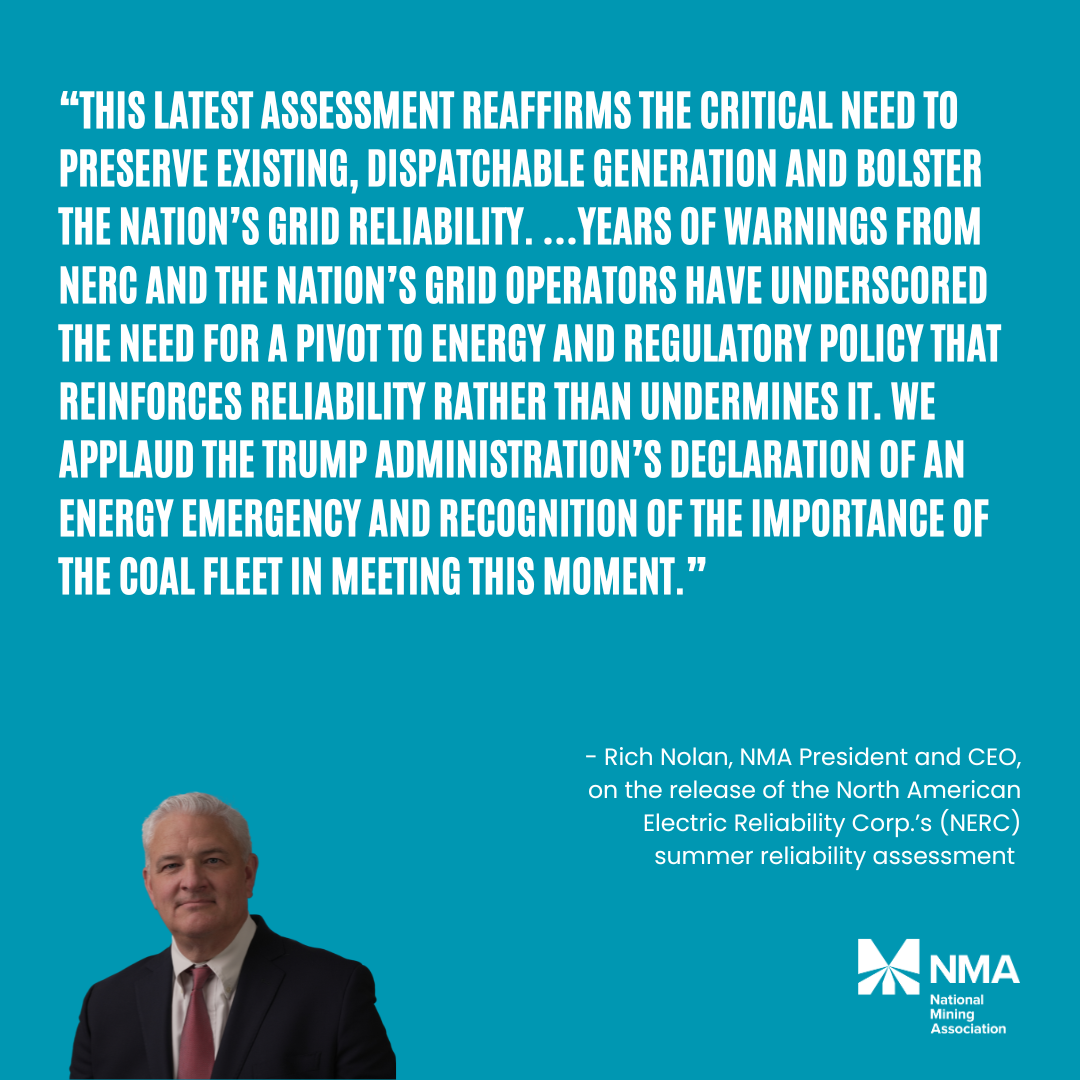
Another Summer of Potential Power Shortfalls
Scorching heat could threaten the nation’s energy supply this summer, with demand eclipsing supply and potentially causing shortfalls and power outages throughout large swaths of the United States, the North American Electric Reliability Corp. (NERC) warned today in its 2025 Summer Reliability Assessment.
NERC underscored that the nation’s grid reliability – facing the twin challenges of surging power demand and greater reliance on variable power – is under elevated stress.
“This latest assessment reaffirms the critical need to preserve existing, dispatchable generation and bolster the nation’s grid reliability,” said Rich Nolan, the National Mining Association’s president and CEO. “The nation’s power supply in far too many states has been pushed to the limit at the very moment we’re facing unprecedented demand growth. Years of warnings from NERC and the nation’s grid operators have underscored the need for a pivot to energy and regulatory policy that reinforces reliability rather than undermines it.”
Demand Growth and Variability
NERC’s assessment specifically points to demand growth as an emerging challenge. NERC found that since last summer, the aggregate of peak electricity demand has risen by over 10 gigawatts (GW)—more than double the year-to-year increase that occurred between the summers of 2023 and 2024.
NERC also pointed to dispatchable power plant retirements and increasing reliance on variable power as points of stress for many operators. “Operators in many parts of the [bulk power system] face challenges in meeting higher demand this summer with a resource mix that, in general, has less flexibility and more variability,” NERC said.
The assessment found that the Midcontinent Independent System Operator (MISO), Southwest Power Pool (SPP) and Electric Reliability Council of Texas (ERCOT) grids, among others, have “elevated” reliability risks this summer, meaning that there’s potential they will have insufficient operating reserves in above-normal conditions. Of course, above-normal conditions at some point this summer are all but a certainty.
ERCOT is already facing a heat wave this spring. In fact, the Texas grid is under close watch with unseasonable heat threatening to break springtime power demand records.
Not included as high-risk in the assessment is the PJM grid, the nation’s largest, and that might be news to the operators there. Just last week, PJM warned in its summer reliability assessment that – for the first time – available generation may fall short during an extreme heat wave.
“This outlook at a record peak heat scenario reflects our years-long and mounting concerns as we plan for enough resources to maintain grid reliability,” said Aftab Khan, PJM’s Executive Vice President – Operations, Planning & Security. “All resources within PJM’s footprint should be prepared to respond when called upon.”
PJM is in a race against the clock to bring new capacity online to meet expected demand growth. PJM recently revised upward by 38% its electricity demand forecast for this coming decade. PJM now expects peak summer power demand to surge to 210 GW in 2035, a jump of 58 GW in a decade. Load growth, particularly from planned data centers, is upending the grid reliability and resource adequacy calculation across the nation.
Coal Meeting Higher Demand
The U.S. Energy Information Administration’s (EIA) latest Short-Term Energy Outlook includes an upward revision for forecasted coal production and consumption. The revised forecast reflects increased coal use of 18% in January and February of this year compared to the same months in 2024. With natural gas prices having doubled in a year and electricity demand up, coal is picking up market share.
Notably, the EIA points to the Trump administration’s efforts to undo the previous administration’s regulatory assault on the coal fleet and keep existing plants running as adding new uncertainty to coal forecasts. In other words, the recent uptick in coal production and demand might very well continue, buoyed by the administration’s efforts to support the fleet and use it as a reliability and affordability backstop.
The Trump administration has recognized the electricity supply emergency now facing the country, underscored by the summer reliability assessments coming from both NERC and PJM. While previous warnings from grid operators and NERC fell on deaf ears, this administration is already acting to address the challenge—a most welcome and urgently needed change.
- On May 14, 2025
